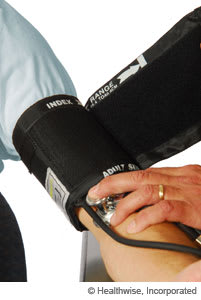Home Blood Pressure Test
Test Overview
Using a home blood pressure monitor lets you keep track of your blood pressure at home. Blood pressure is a measure of how hard the blood pushes against the walls of your arteries as it moves through your body.
Your blood pressure is recorded as two numbers.
- The first number shows how hard the blood pushes when the heart is pumping. This is the systolic pressure.
- The second number shows how hard the blood pushes between heartbeats, when the heart is relaxed and filling with blood. This is the diastolic pressure.
Someone with a systolic pressure of 120 and a diastolic pressure of 80 has a blood pressure of 120/80, or "120 over 80." Blood pressure is measured in millimeters of mercury (mm Hg).
Automatic blood pressure monitors
Most people use an automatic monitor to measure their blood pressure at home. These are also called electronic or digital monitors. They have a microphone to detect blood moving through the artery. The cuff wraps around your upper arm. When you press the start button on the monitor, the cuff automatically inflates. Then the cuff automatically deflates, and the monitor takes your blood pressure.
Health Tools
Health Tools help you make wise health decisions or take action to improve your health.
Why It Is Done
You may check your blood pressure at home to:
- Find out if you have high blood pressure. Your blood pressure can change throughout the day. And sometimes blood pressure is high only because you are at the doctor's office. This is called white-coat hypertension. To diagnose high blood pressure, your doctor needs to know if your blood pressure is high throughout the day.
- Track your blood pressure if you have high blood pressure.
- Keep track of how well your blood pressure medicine is working.
- Check if your blood pressure is affected by lifestyle changes, such as weight loss and exercise. Home monitoring can help you feel more involved in and more in control of your health care.
- Watch for changes in blood pressure that may be side effects of medicines.
- Check for problems with high blood pressure during pregnancy, which may be a sign of preeclampsia.
How To Prepare
Before you take your blood pressure
- Don't drink caffeine, smoke, or exercise for at least 30 minutes before you take your blood pressure.
- Empty your bladder before the test.
- Sit with your back supported and both feet on the floor.
- Rest quietly for at least 5 minutes before you take a reading.
How It Is Done
- If your doctor recommends it, take your blood pressure twice a day. Take it in the morning and evening.
- Sit with your arm slightly bent and resting on a table so that your upper arm is at the same level as your heart.
- Use the same arm each time.
- Place the blood pressure cuff on the bare skin of your upper arm. You may have to roll up your sleeve, remove your arm from the sleeve, or take your shirt off.
- Wrap the blood pressure cuff around your upper arm so that the lower edge of the cuff is about 1 in. (2.5 cm) above the bend of your elbow.
- Sit with your back supported and both feet on the floor.
- Do not move, talk, or text while you take your blood pressure.
Follow the instructions that came with your blood pressure monitor. They might be different from the following.
- Press the start button. The cuff will inflate and slowly deflate by itself.
- Your blood pressure numbers will appear on the screen.
- Wait one minute and take your blood pressure again.
- If your monitor does not automatically save your numbers, record them in your blood pressure log along with the date and time. Also record any medicine you took and any activities you did.
Getting a blood pressure cuff that fits

It is important that the blood pressure cuff is the right size for your arm: not too large and not too small. The inflatable part of the cuff can't overlap too much. But it needs to be long enough to go all the way around the widest part of your upper arm. If you will be monitoring your blood pressure at home, ask your doctor or nurse to check to make sure the cuff fits correctly.
How It Feels
The blood pressure cuff will feel a little tight when the cuff inflates and squeezes your arm.
Results
Your systolic and diastolic pressures are both important. Most medical guidelines say a normal blood pressure measurement is less than 120/80 mmHg. Your doctor will give you a goal for your blood pressure. Your goal will be based on your health and your age.
It's normal for blood pressure to go up and down throughout the day. But if it stays up, you have high blood pressure. Your doctor may want to track the results of your blood pressure over time to see if it stays in a high or low range.
In general, the lower your blood pressure, the better. For example, a blood pressure reading of less than 90/60 is healthy as long as you feel okay.
Credits
Current as of: October 2, 2025
Author: Ignite Healthwise, LLC Staff
Clinical Review Board
All Ignite Healthwise, LLC education is reviewed by a team that includes physicians, nurses, advanced practitioners, registered dieticians, and other healthcare professionals.





